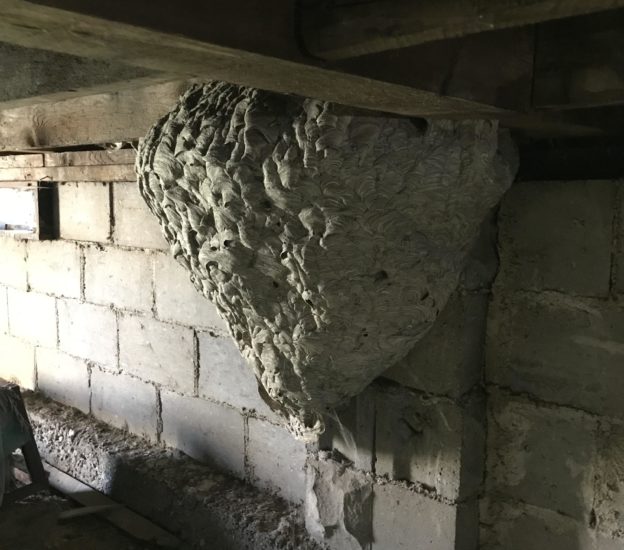This beach ball sized wasp nest was found under my client’s front porch. This is not uncommon as they like to build nexts under eaves, porch ceilings and overhangs. They often choose a corner spot where the nest will be more protected. Some wasps are very territorial and aggressive so best to stay clear of the nest.
How to Get Rid of Wasps and Hornets
Wasp & hornet control can be accomplished in one visit. We can either treat an active nest directly or provide a preventive treatment so nest don’t get a chance to start. We remove all visible nests from the house. Yellow jacket nest removal from wall voids is available.
All services include a minimum of 30 Day Warranty
Be fully covered with one of our Flexible Maintenance Plans
Identifying Your Wasp or Hornet
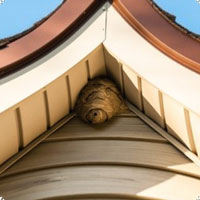 Paper Wasps
Paper Wasps
Paper wasps are perhaps the most common wasps around structures. They are also known as “umbrella wasps” because their nests look like umbrellas hanging upside-down from eaves and overhangs. Common species include the northern paper wasp, a black to reddish-brown wasp up to ¾-inch long, and the European paper wasp which is black and yellow, resembling a yellowjacket.
A paper wasp nest is a single comb of hexagonal cells made of a papery material the wasps form by chewing wood and mixing it with saliva. Larger nests can harbor up to 75 paper wasps including larvae and pupae developing within the cells. Many find their way into structures and are later seen crawling sluggishly across the floor when temperatures rise in late winter or early spring.
Yellowjackets
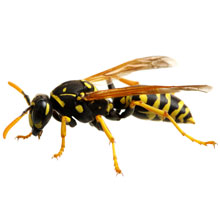 More people are stung by yellowjackets than any other type of wasp or bee. Notoriously aggressive, the yellowjacket’s shiny yellow and black striped abdomen is an unmistakable warning. They construct paper nests up to several feet across that contain combs arranged like the floors of a building covered by a papery envelope. Up to 3,000 (many more in warmer states) wasps can be present in the yellowjacket colony. When temperatures cool in late summer, yellowjacket numbers peak just as their insect food supply begins to decline. They scavenge more aggressively at this time, taking food from trash containers and picnickers. When disturbed, some yellowjackets sting repeatedly, while others sting and lose their stingers as do honey bees.
More people are stung by yellowjackets than any other type of wasp or bee. Notoriously aggressive, the yellowjacket’s shiny yellow and black striped abdomen is an unmistakable warning. They construct paper nests up to several feet across that contain combs arranged like the floors of a building covered by a papery envelope. Up to 3,000 (many more in warmer states) wasps can be present in the yellowjacket colony. When temperatures cool in late summer, yellowjacket numbers peak just as their insect food supply begins to decline. They scavenge more aggressively at this time, taking food from trash containers and picnickers. When disturbed, some yellowjackets sting repeatedly, while others sting and lose their stingers as do honey bees.
Hornets
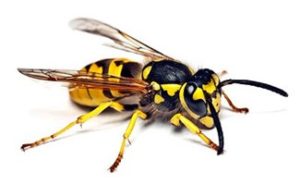 The so-called bald-faced hornet, about ¾-inch long, black and white, with white face, is actually a larger yellowjacket species. Its nest is the familiar basketball-size papery oval hanging from tree limbs and sometimes structures. Colonies are relatively small, containing up to 700 wasps. Nests occur in trees and in attics and wall voids of structures near forested areas.
The so-called bald-faced hornet, about ¾-inch long, black and white, with white face, is actually a larger yellowjacket species. Its nest is the familiar basketball-size papery oval hanging from tree limbs and sometimes structures. Colonies are relatively small, containing up to 700 wasps. Nests occur in trees and in attics and wall voids of structures near forested areas.
Mud Daubers (Sceliphron caementarium, Chalybion californicum, Tropoxylon spp.)
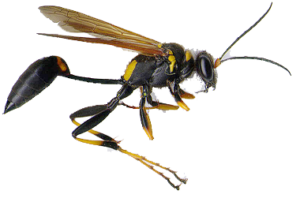 Mud dauber wasps are named for their habit of constructing tubular nests of mud plastered on the exterior surfaces of structures. Inside the nest, these wasps place spiders they have paralyzed by stinging, as food for their larvae. Mud daubers are solitary wasps about ¾-inch long. Our common mud dauber is brownish-black with yellow markings. Its nests are about 2 inches long. Organ pipe mud daubers are black and construct nests that can be a foot long and resemble the pipes of a pipe organ. The blue mud dauber is a shiny, dark blue wasp that lays its eggs in the nests of other mud daubers.
Mud dauber wasps are named for their habit of constructing tubular nests of mud plastered on the exterior surfaces of structures. Inside the nest, these wasps place spiders they have paralyzed by stinging, as food for their larvae. Mud daubers are solitary wasps about ¾-inch long. Our common mud dauber is brownish-black with yellow markings. Its nests are about 2 inches long. Organ pipe mud daubers are black and construct nests that can be a foot long and resemble the pipes of a pipe organ. The blue mud dauber is a shiny, dark blue wasp that lays its eggs in the nests of other mud daubers.

